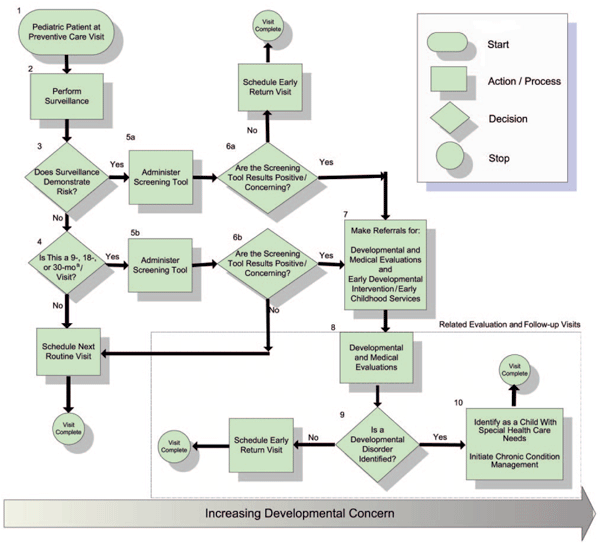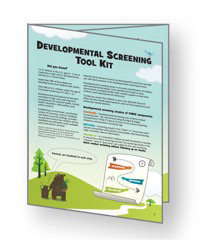Introduction to Developmental Surveillance and Screening
 Surveillance and screening are different, but related and complimentary activities.
Surveillance and screening are different, but related and complimentary activities.
Developmental surveillance: an ongoing process that professionals can use to identify concerns. It involves the systematic collection of data over time and is best done in partnership with parents.
The American Academy of Pediatrics and the Council on Children with Disabilities (2006) have identified five components of developmental surveillance:
- eliciting and attending to parents’ concerns about their child’s development
- documenting and maintaining a developmental history
- making accurate observations of the child
- identifying risk and protective factors
- maintaining an accurate record of documenting the process and findings.
Developmental screening: the use of standardized measures to identify children who may need further more systematic and focused evaluation.
Screening instruments are designed to be an initial step toward more comprehensive evaluation and diagnostic assessment. As such screening instruments should be efficient, quick, and relatively inexpensive to administer.
Additionally. the following principles apply to screening:
- Screening provides useful information about a child’s development.
All families can benefit from developmental screening of their children. If a child screens positive, a referral should be made to an appropriate agency or program to provide further assessment and evaluation. The earlier the problems are identified the sooner appropriate supports and services can be provided to ensure a child’s optimal development. - Screening involves the use of a standardized tool and is an ongoing process.
Use of valid and reliable tools increases detection rates of children with developmental disabilities and mental health problems. A valid tool is a tool that measures what it intends to measure. A reliable tool is a tool that gives similar results in different settings. - Screening takes into account a child’s and family’s individual circumstances.
It is best to seek additional information any time screening results are concerning, but screening results may be influenced by a variety of factors in a child’s life. - Screening is culturally sensitive.
Culture plays a major role in a child’s development. It influences norms, expectations, and screening interpretation. - Screening requires follow-up.
All screening needs to be followed by conversations with families about the meaning of results. Children with concerning screens require further assessment to determine unique strengths and needs, as well as referrals to programs offering appropriate supports and services. Children with reassuring screens need re-screening at appropriate intervals ensure that their development continues to be on-track.
Why Use Validated Screening Tools
- 25-30% of problems noted by parents during well-child visits are developmental/behavioral, as frequently as otitis media, asthma, normal development (Boreman, 2007)
- Pediatricians fail to refer children with developmental disabilities approximately 60-80% of the time (Hix-Small et al, 2007; Rhoades et al., 2007)
- Parents report average delay of 9 months before autism referral, up to 40% report having no confidence in pediatrician to identify and refer for ASD (Harrington et al., 2006; Rhoades et al., 2007)
Studies have shown that many physicians rely on intuition, clinical judgment and developmental checklists to detect potential developmental problems despite the availability of standardized screening tools this practice has been shown to identify fewer than half of children with developmental delay (Glascoe & Dworkin, 1993).
In contrast, validated tools provide standardized cut-offs for the number of missed milestones that indicate a need for referral and help guide practice and assure uniform care for all patients.
In turn, children identified with delays can access early intervention services which have been shown to improve long-term developmental outcomes. Children who have participated in Early Intervention services have had higher graduation rates, higher employment rates, and less criminality than those who did not receive services.
AAP Recommendations/Algorithm
In a 2006 Policy Statement, the American Academy of Pediatrics (AAP) published their algorithm for developmental screening and surveillance.
In their paper titled “Medical Home: An Algorithm for Developmental Surveillance and Screening Identifying Infants and Young Children With Developmental Disorders,” the AAP recommends:
General Developmental Screening:
- 9 months
- 18 months
- 24/30 months
Autism-Specific Screening:
- 18 months
- 24/30 months



